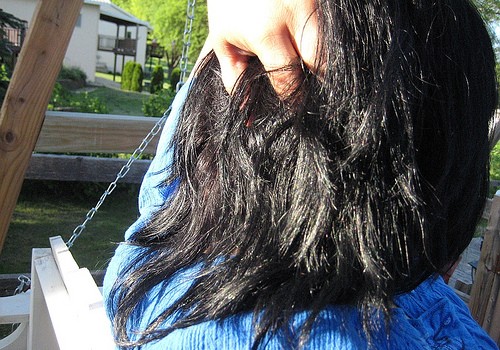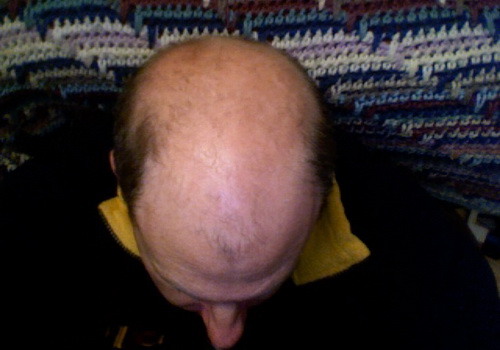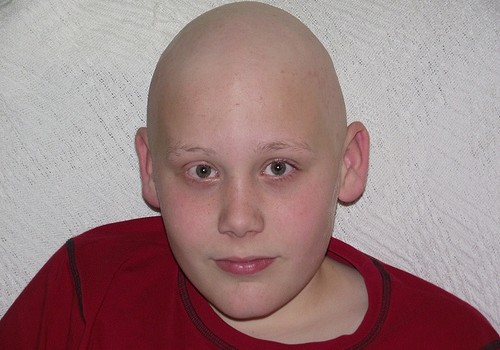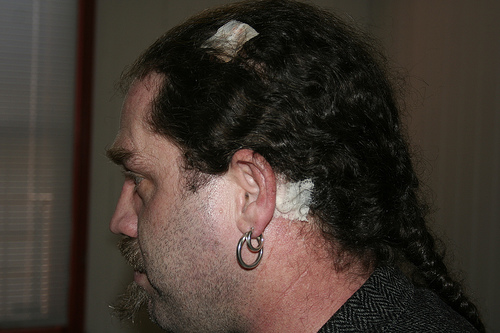
Normal Hair Growth
Before the most common hair disorders are discussed, we need to understand how our hair normally grows. Normally, hair grows in three phases. These phases are the anagen, catagen, and telogen phases. In the anagen phase, the hair begins its growth cycle. The catagen phase renews the follicle which pushes the hair shaft up. The final phase is the resting phase that the hair and follicle go through. Hair can actually remain dormant up to four months before the cycle stars over. The time for one hair to grow from the beginning phase until the end is approximately two to six years.
- Important notification about information and brand names used in this slideshow!
- Photo courtesy of tommerton2010 by Flickr : www.flickr.com/photos/58842866@N08/5388151233/
- umm.edu/health/medical/altmed/condition/hair-disorders
- http://www.betterhealth.vic.gov.au/bhcv2/bhcarticles.nsf/pages/Hair?open
- http://www.gurl.com/2013/05/23/what-is-trichotillomania-hair-pulling/
- http://www.niams.nih.gov/Health_Info/Alopecia_Areata/alopecia_areata_ff.asp

What Causes Hair Disorders?
It is important to remember that the average person can shed up to a hundred hairs a day without having a hair disorder. The difference occurs when hair loss or changes are visible to the eye — for example, a section of your head completely without hair. Many people find that their hair starts to thin with age due to the body’s metabolic rate dropping. Many common medical conditions can cause the hair to shed more quickly than it is supposed to. The hair loss that is seen with certain medical conditions can also be worsened by medications. Hormones can also be a factor to hair loss.
- Important notification about information and brand names used in this slideshow!
- Photo courtesy of Pahz by Flickr : www.flickr.com/photos/psexypsychic/4709948535/

Male Pattern Baldness
The most common cause of hair loss in men is male pattern baldness. Male pattern baldness is when the follicles become smaller, causing the hair to thin. This is the typical reason that the hair line recedes or a spot on the back of the head emerges. Male pattern baldness will affect around seventy percent of men before they die. There are many causes of male pattern baldness although the most common factor is age. When the body ages, the metabolic rate that the body preforms at slows. This causes the necessary hormones to drop and the hair does not grow as thick as it did in their younger years.
- Important notification about information and brand names used in this slideshow!
- Photo courtesy of Smobserver by Wikimedia Commons : commons.wikimedia.org/wiki/File:Bald_head.jpg

Alopecia Is A Common Hair Disorder
Alopecia is one of the most common hair disorders that both men and women suffer from. Alopecia can occur at any age. There are many different causes of this hair disorder. One of the most common causes is alopecia areata which is an autoimmune disease that will cause the hair to fall out for no apparent reason. This form of alopecia is characterized by patches on the body that have gone bald. Another direct cause that is mainly found in women excessive pressure on the hair. This can be caused by the many methods of hair removal or by having your hair style way too taunt on the head.
- Important notification about information and brand names used in this slideshow!
- Photo courtesy of meke by Flickr : www.flickr.com/photos/meke/6410937213/

Hirsutism – A Female Hair Disorder
Hirsutism is a common hair disorder that causes women to grow excessive hair on their bodies. Hirsutism causes women to develop chest, beard, back, and facial hair. Women normally show signs of this common hair disorder during puberty. Hirsutism is caused by either a sensitivity to the male hormones that occur naturally in the body. The other reason that woman develop this hair disorder is because their bodies over-produce male hormones. The reason that the levels of the male hormones being above normal can also be caused by many different things. One of the causes is due to medical conditions that prevent the ovaries from functioning correctly.
- Important notification about information and brand names used in this slideshow!
- Photo courtesy of txkimmers by Flickr : www.flickr.com/photos/txkimmers/19867340/

Hair Shaft Disorders Enhance Hair Loss
There are many disorders that cause physical damage to the hair shaft, resulting in hair loss. This can be caused by the fiber of the hair being damaged because it was not properly formed in the hair shaft. These are normally genetic defects and have been experienced by the people that have these disorders all of their lives. Many are diagnosed during the early parts of childhood when parents see that their hair does not grow normally. Sometimes the cuticle of the hair does not develop, making the hair brittle and easy to remove. Some of these disorders will go away or improve with time, while others will remain.
- Important notification about information and brand names used in this slideshow!
- Photo courtesy of Liz Poage by Flickr : www.flickr.com/photos/liz-grace/5566256131/

Hair Infections Might Develop Overnight
Just like any other part of the body, hair can get infected. Certain infections, like ringworm, will cause hair loss. Ringworm can occur on any body area covered by skin, including the scalp. If ringworm develops on the scalp, the area that the fungus has infected will become temporarily bald. The fungus infects the hair as well as the scalp. This makes hairs brittle and causes them to break off. The infected scalp is normally inflamed, itchy, and tends to form blisters that ooze. It is important to remember that people can spread this through hairbrushes, pool surfaces, shower surfaces, and unwashed clothes.
- Important notification about information and brand names used in this slideshow!
- Photo courtesy of Pedro fp by Flickr : www.flickr.com/photos/bandidoofoz/766427783/

Trichotillomania: The Irresistible Urge To Pull Out Your Own Hair
Trichotillomania is the compulsive act of pulling out your hair. There are some cases where people actually eat their own hair. This typically leads to not only noticeable hair loss, but also causes social and functional impairment depending on the severity of the disorder. This common hair disorder may be caught in infants but is more accurately diagnosed in later years. This is seen as a cousin of obsessive compulsive disorder since it seems to share many of the same features as the well-known disease. Trichotillomania and OCD also share some of the same genetic markers, leading many to believe that this may be another part of OCD.
- Important notification about information and brand names used in this slideshow!
- Photo courtesy of MDragunov by Wikimedia Commons : zh.m.wikipedia.org/wiki/File:Trichotillomania_2.jpg

How To Treat Different Hair Disorders?
To treat the hair loss that you or a loved one suffer from, the first step is to see your doctor so that they can help you figure out what is causing the hair loss. If it is an infection, your doctor will treat the infection which should stop the hair loss. If a behavioral disorder is the cause, therapy may be needed to help the patient cope with the problem. Hormonal therapy or other treatment options may slow down or even repair other disorders. Only a doctor will know exactly how to treat the cause of the disorder which is why it is important to seek medical attention.
- Important notification about information and brand names used in this slideshow!
- Photo courtesy of Maegan Tintari by Flickr : www.flickr.com/photos/lovemaegan/5388982993/

Could Hair Disorders Be Prevented?
Some hair disorders can be prevented. It depends on the disorder and what is causing it. With advancements in gene therapy, there is more hope than ever for those that have hair loss. Gene therapy can reverse the effects of the disorder and allow the body to heal itself. When the body has a chance to heal, it can restore the hair and scalp to look like it never happen. In the past twenty years, we have seen a huge advancement in how we treat disorders, giving people their lives back. Just imagine how much the medical field will advance in the next twenty years.
- Important notification about information and brand names used in this slideshow!
- Photo courtesy of Samantha Steele by Flickr : www.flickr.com/photos/samanthasteele/3952752595/



























Your thoughts on this
Loading...